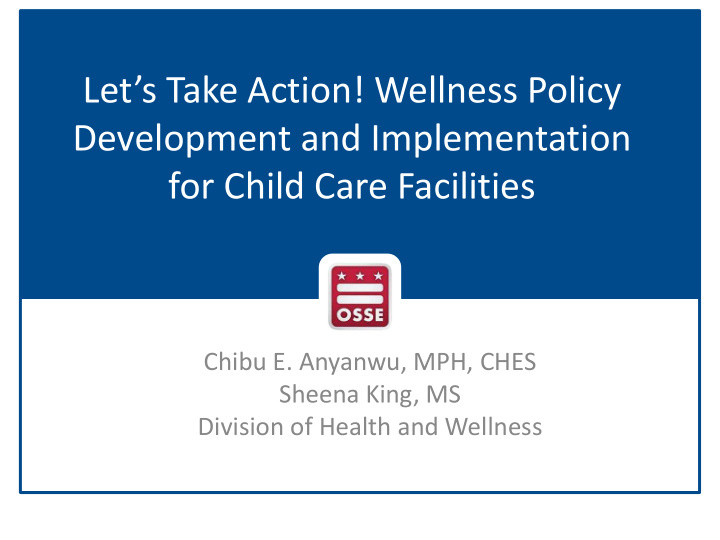



Let’s Take Action! Wellness Policy Development and Implementation for Child Care Facilities Chibu E. Anyanwu, MPH, CHES Sheena King, MS Division of Health and Wellness
Workshop Objectives • Develop an understanding of a wellness policy and the benefits of implementing one in your ECE facility • Discuss a drafting wellness policy specific to the areas of need for your ECE facility, including physical activity, nutrition, food service guidelines, environmental sustainability, etc. • Engage in interactive discussions on different components of sections in the Healthy Tots Act Early Child Care Wellness areas and usage in your ECE
Icebreaker
Healthy Tots Wellness Areas
Healthy Tots Wellness Areas 1. Serving nutritious, tasty meals 2. Promoting physical activity 3. Enhancing facility environmental sustainability 4. Providing effective nutrition and healthy eating education 5. Ensuring wellness professional development for staff 6. Partnering with families to promote facility wellness
Wellness Policy Overview
What is a Wellness Policy? Defined as “a set of statements around the specific practices promoted at your program. The day-to-day practices of your program play a key role in helping children develop healthy eating and physical activity habits.”
Components of a Wellness Policy They may entail goals and standards around the following: • Nutritional practices (how children will be fed at your program) and education, • Physical activity practices and education, and • Food Service Guidelines • Promoting Healthy Eating in the Child Care Setting • Staff Wellness • Community Involvement
Benefits of a Wellness Policy in Your ECE Facility • Communicate core values and principles regarding healthy habits to child care providers, as well as, current and potential families and to the community. • Help child care providers and families act as role models for children by practicing healthy habits themselves. • Set a standard that is clear and consistent (which avoids future misunderstandings). • Help guide those teaching children about the importance of these healthy habits.
Ways to share Your Wellness Policy • Welcome or registration packet for new families • Family handbook • Employee handbook • Family newsletters • Bulletin board or posters • Family meetings • Website
HTA Wellness Assessment
HTA Wellness Assessment Group Discussion – 3 things you like – 3 things you would change – barriers to implementation – standards your organization are currently implementing
Create and Implement Your Wellness Policy
Creating Your Wellness Policy 7 Key Steps 1. Build a strong team 2. Assess the environment 3. Draft the policy 4. Adopt the policy 5. Implement the policy 6. Measure and Evaluate 7. Communicate the results
Local Wellness Policy Template Ensuring Quality Nutrition Education, Health Education and Physical Education [ECE FACILTY OR SCHOOL NAME] aims to provide age-appropriate and culturally sensitive instruction in nutrition, health and physical education that help children develop the knowledge, attitudes, and skills to enjoy healthy eating habits and a physically active lifestyle. Health and Nutrition Education [ECE FACILTY OR SCHOOL NAME] will provide nutrition education that: • Is appropriate for children’s ages and teaches basic nutrition concepts, including dietary recommendations and the impact of childhood obesity; • Offers learning experiences that reflect children’s cultures; • Incorporates activities to teach the importance of proper nutrition to children’s overall well-being and school success. • Is incorporated into math and reading lessons, as well as dramatic play; • Create opportunities for children to practice new skills and have fun • Choose nutrition education learning materials that are easy and enjoyable to teach; • Promotes increase serving of fruits and vegetables, whole grain products, low- fat and fat-free dairy products, healthy food preparation methods, and health- enhancing nutrition practices; • Links with the Child and Adult Care Food Program (CACFP) and nutrition- related community services.
Local Wellness Policy Template Rewards [ECE FACILTY OR SCHOOL NAME] will not use foods or beverages as rewards, incentives, or prizes for academic performance or good behavior. 2 Water To promote hydration, free, potable drinking water will be available to all students throughout the day. [ECE FACILTY OR SCHOOL NAME] will make drinking water available where school meals are served during mealtimes.
The DC Healthy Tots Act Wellness Guidelines Planning Tool
DC Healthy Tots Act Wellness Guidelines Planning Tool Instructions: Please use the Healthy Tots Wellness Guidelines to fill in the spaces. Next, utilize the DC Child Care Centers Promoting Lifelong Activity in Youth (P.L.A.Y) Program Local Wellness Template to implement and create a plan to achieve your goals. This tool has been adopted from the DC Child Care Centers Promoting Lifelong Activity in Youth (P.L.A.Y) Program Local Wellness Template and can be used to create, implement and achieve your wellness goals. Providing Effective Nutrition & Healthy Eating Education [ECE FACILTY OR SCHOOL NAME] aims to provide age-appropriate and culturally DC Healthy Tots Act sensitive instruction in nutrition, health and physical education that help children develop Wellness Guidelines the knowledge, attitudes, and skills to enjoy healthy eating habits and a physically active lifestyle. Planning Tool List your top (3) List your top (3) areas of List your top (3) pre- List your top (3) high strengths: improvement: existing focus area: priority licensing guideline areas that need to be addressed: 1. 1. 1. 1. 2. 2. 2. 2. 3. 3. 3. 3.
Questions?
Source Citation: Anyanwu, C. and King, S. (2017, August 5). Let’s Take Action! Wellness Policy Development and Implementation for Child Care Facilities [PowerPoint slides].
Recommend
More recommend